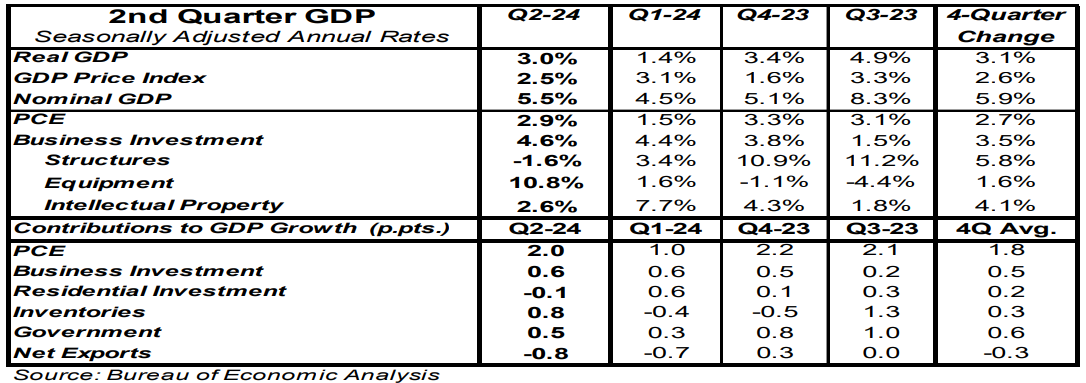- Real GDP growth in Q2 was revised upward to a 3.0% annual rate from a prior estimate and consensus expected 2.8%.
- Upward revisions to personal consumption more than offset small downward revisions to every other major category.
- Personal consumption, business fixed investment, and home building, combined, rose at a 2.9% annual rate in Q2. We refer to this as “core” GDP.
- The GDP price index was revised higher to a 2.5% annual growth rate from a prior estimate of 2.3%. Nominal GDP growth – real GDP plus inflation – was revised upward to a 5.5% annualized rate from a prior estimate of 5.2%.
Implications: Hold off on GDP for a moment. The most important data in this morning’s report was on economy-wide corporate profits, which rose 1.7% in the second quarter vs. the first quarter and are up 8.0% from a year ago. Leading the increase were profits from domestic industries, which rose 2.7% from the previous quarter. Profits from the rest of the world fell in the second quarter by 3.5%. Financial industry data include the Federal Reserve (either profits, or losses) and because the Fed pays private banks interest on reserves, and has raised interest rates, it has been generating unprecedented losses in recent quarters. Excluding the losses at the Fed (because we want to accurately count profits in the private sector), overall corporate profits were up 1.3% in the second quarter and up 6.4% from a year ago. Plugging in non-Fed profits into our Capitalized Profits Model suggests stocks remain overvalued. Looking at the other details of today’s report, second quarter real GDP was revised upward to a 3.0% annual rate versus a prior estimate of 2.8%. The upward revision was all due to more personal consumption in services and non-durable goods. This increase offset small downward revisions in all other major categories. To focus on sustainable growth drivers, we follow "core" GDP, which includes consumer spending, business fixed investment, and home building, while excluding government purchases, inventories, and international trade, which are too volatile for long-term growth. “Core” GDP increased at a 2.9% annual rate in Q2, higher than the prior estimate of 2.6%. We also got a first look at the Q2 total for Real Gross Domestic Income, an alternative to GDP that is just as accurate. Real GDI rose at a 1.3% annual rate in Q2 and is up 2.0% versus a year ago. In other words, GDI suggests today’s report may overstate growth a little. On the inflation front, the GDP price index was revised slightly higher to a 2.5% annual rate in Q2 versus a prior estimate of 2.3% and up 2.6% from a year ago, both above the Fed’s 2.0% target. In other news this morning, initial claims for unemployment insurance fell 2,000 to 231,000 last week, while continuing claims increased 13,000 to 1.868 million. On the housing front, home prices were mixed in June. The Case-Shiller index increased 0.2% for the month and is up 5.4% from a year ago; the FHFA index ticked lower by 0.1% in June but is up 5.2% from a year ago. In the manufacturing sector, the Richmond Fed index fell to -19 in August from -17 in July. Also, the Federal Reserve released monthly figures on M2, showing it up 0.1% in July and up 1.3% in the past year. M2 surged during COVID, then declined from early 2022 through early 2023. It has stopped declining, but isn’t rising rapidly, which should put continued downward pressure on the growth rate of inflation and nominal GDP.





